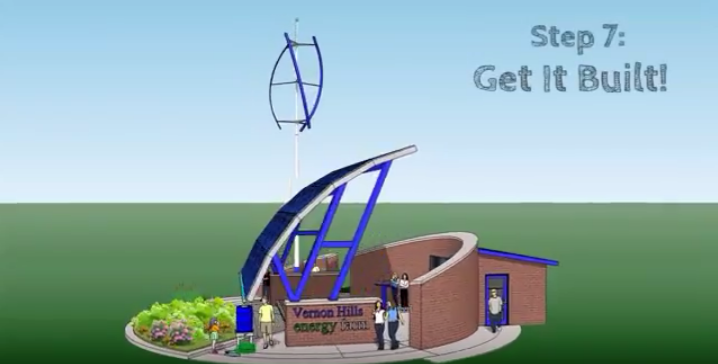Mulcrone brothers blow away Vernon Hills with energy plan
Courtesy of the Mulcrone brothers
This illustration depicts a potential design for an energy efficient classroom.
Walking through the VHAC, the Mulcrone brothers envision the future of Vernon Hills’ renewable energy. They imagine the wind turbines standing tall, capturing the high winds of the area to power the bright lights of the facility through their clean energy initiative.
Jack Mulcrone (12) and Devin Mulcrone (9) have created a clean energy plan for Vernon Hills in hopes to improve the way our school impacts the environment. The entire idea consists of two parts: wind turbines at the VHAC to light the fields and a clean energy classroom for the high school.
“It’s really upsetting to see how people don’t really care about protecting [the environment] and are trying to move away from having fun outside,” Jack said.
As of now, the project is still in the discovery phase. The boys have been reaching out to different engineers in the community to help with designing. Before they can come up with a definitive cost and funding plan for the project, the Mulcrones are developing the specifics of the design.
The two brothers came up with the idea last year after Jack returned from a trip to Iceland. Jack was inspired by the renewable energy used extensively in Iceland and wondered how Vernon Hills could introduce something similar.
They first thought of a classroom that would run completely on renewable energy using things like a solar panel array, a rainwater harvesting system and a composting washroom. The main premise is to educate students and demonstrate what can be done to save energy.
They then thought of also using the wind from the sports complex. According to Jack, the cross country coaches and athletes have complained about how windy it gets at the stadium. Also, he has seen some coaches wait until the last minute to turn on the lights because of how expensive it is to power the athletic facilities.
Inspired by the issues they experienced, the Mulcrones came up with the second part of their initiative: 15-20 wind turbines along Fairway Drive, generating energy to light all of the athletic facilities and the parking lot of the high school.
“We can’t change the weather, but we think we can change how we feel about it,” Jack said. “Why don’t we try to make the weather a good thing and a positive force?”
The turbines, anticipated to cost $15,000 to $20,000 each, would be built on land owned by the government but leased by the high school.
Once the idea was formed, they started presenting to different people and government entities in Vernon Hills that advocate for the environment.
When the Mulcrones first presented the initiative to Dr. Guillaume, the principal was blown away by the idea.
“I think that’s pretty powerful,” Dr. Guillaume said. “If two kids or one kid or a group of kids or a whole class can tackle an initiative for the greater good, I think that’s fantastic.”
According to Dr. Guillaume, if the project is implemented fully, it will impact the school significantly financially due to the electricity it would generate. But whether or not the full initiative will be implemented is still unclear. A smaller version of the project might include simply having the clean energy classroom to educate students.
“I can see some of our clubs, whether it’s VH2O or courses like AP Environmental Science, being able to do some really hands-on, practical educational experiences using that,” Dr. Guillaume stated.
According to Devin, the first time they presented to the Vernon Hills Village Board, questions arose regarding price and the actual layout of the project. But before they determine when the community would start seeing cost savings, they need more people to help design the whole facility; they have been working to recruit help from local civil and mechanical engineers.
“There are so many pieces to doing something like this,” Jack said. “So, we’d really have to figure out things like zoning and the bureaucracy behind what it would take to build something like this.”
But even with all the obstacles the Mulcrones have faced and Jack going off to college next year, the brothers are willing to keep working until the project is complete. Devin hopes that by the time he is a senior, the project will be more developed and possibly have started construction.
“That would be really huge accomplishment, knowing that we started [this initiative],” Devin said.

